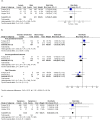Another piece of the Zika puzzle: assessing the associated factors to microcephaly in a systematic review and meta-analysis
- PMID: 32487247
- PMCID: PMC7266116
- DOI: 10.1186/s12889-020-08946-5
Another piece of the Zika puzzle: assessing the associated factors to microcephaly in a systematic review and meta-analysis
Abstract
Background: Although it is known that Zika virus (ZIKV) infection during pregnancy may lead to microcephaly in the fetus, the prognostic factors associated with this tragic disorder remain unclear. We conducted a systematic review and meta-analysis to assess the prognostic factors associated with the incidence of microcephaly in congenital ZIKV infection.
Methods: We conducted a comprehensive search in Ovid MEDLINE, Ovid MEDLINE (R) Epub ahead of print, Embase, Embase Classic, Web of Science, CINAHL, Cochrane CENTRAL, LILACS, and various thesis databases to identify human studies reporting microcephaly associated with congenital ZIKV infection. We requested primary data from the authors of the included studies to calculate summary estimates and conduct the meta-analysis of the most prevalent factors.
Results: We screened 4106 titles and abstracts, and identified 12 studies for inclusion in the systematic review. The assessment of ZIKV infection and the definition of microcephaly varied among studies. A total of 6154 newborns/fetuses were enrolled; of those, 1120 (18.20%) had a diagnostic of ZIKV infection, of which 509 (45.45%) were diagnosed with microcephaly. Nine studies addressed the link between congenital ZIKV infection and neurological findings in newborns/fetuses. Half of the studies provided primary data. Three out of 11 factors of interest seem to be prognostic factors of microcephaly: infant's sex - males compared to females: Relative Risk (RR) 1.30, 95% Confidence Interval (95% CI) 1.14 to 1.49; the stage of pregnancy when infection occurred - infection in the first trimester of pregnancy compared to infection at other stages of pregnancy: RR 1.41, 95% CI 1.09 to 1.82; and asymptomatic infection compared to symptomatic infection during pregnancy: RR 0.68; 95% CI 0.60 to 0.77.
Conclusion: Our findings support the female-biased resistance hypothesis and reinforce the risk associated with the stage of pregnancy when ZIKV infection occurs. Continued surveillance of ZIKV infection during pregnancy is needed to identify additional factors that could contribute to developing microcephaly in affected fetuses.
Protocol registration: This systematic review was registered with the International Prospective Register of Systematic Reviews (PROSPERO), registration no. CRD 42018088075.
Keywords: Congenital Zika syndrome; Congenital disease; Microcephaly; Pregnancy; Risk factors; Systematic review; Zika virus.
Conflict of interest statement
The authors declare that they have no competing interests.
Figures
References
-
- WHO. WHO statement on the first meeting of the International Health Regulations (2005) (IHR 2005) Emergency Committee on Zika virus and observed increase in neurological disorders and neonatal malformations [Internet]. Statement. 2016 [cited 2016 May 20]. Available at: http://www.who.int/en/news-room/detail/01-02-2016-who-statement-on-the-f...(2005)-(ihr-2005)-emergency-committee-on-zika-virus-and-observed-increase-in-neurological-disorders-and-neonatal-malformations.
-
- Krauer F, Riesen M, Reveiz L, Oladapo OT, Martinez-Vega R, Porgo T V, et al. Zika Virus Infection as a Cause of Congenital Brain Abnormalities and Guillain-Barré Syndrome: Systematic Review. Plos Med [Internet]. 2017 Jan;14(1):e1002203. Available at: http://ovidsp.ovid.com/ovidweb.cgi?T=JS&CSC=Y&NEWS=N&PAGE=fulltext&D=eme.... - PMC - PubMed
-
- Wang J-N, Ling F. Zika Virus Infection and Microcephaly: Evidence for a Causal Link. Int J Environ Res Public Health [Internet]. 2016 Oct;13(10):1031. Available at: http://ovidsp.ovid.com/ovidweb.cgi?T=JS&CSC=Y&NEWS=N&PAGE=fulltext&D=eme.... - PMC - PubMed
-
- Chibueze EC, Tirado V, Lopes K, Da S, Balogun OO, Takemoto Y, Swa T, et al. Zika virus infection in pregnancy: a systematic review of disease course and complications. Reprod Health [Internet]. 2017 28 [cited 2017 Sep 5];14(1):28. Available at: http://ovidsp.ovid.com/ovidweb.cgi?T=JS&CSC=Y&NEWS=N&PAGE=fulltext&D=eme.... - PMC - PubMed
Publication types
MeSH terms
Grants and funding
LinkOut - more resources
Full Text Sources
Medical



